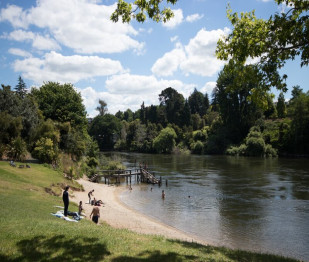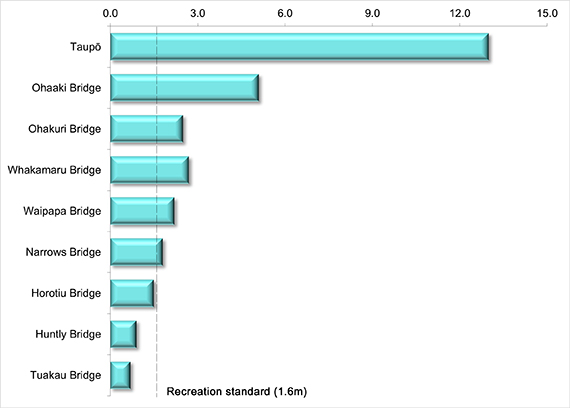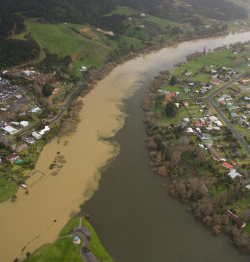How clean is the Waikato River?
 Water quality in the Waikato River is much better than it was in the 1950s. Urban waste water treatment has improved considerably.
Water quality in the Waikato River is much better than it was in the 1950s. Urban waste water treatment has improved considerably.
Despite being the most intensively used river in the country, the Waikato's water quality is considered to be excellent compared to other rivers around the world.
You might be wondering just how good the water in the Waikato River is these days. Is it safe for swimming? Can fish live in it? The answer depends on what part of the river we look at.
Since 1989 the Waikato Regional Council has measured water quality every month at ten sites along its length.
Water quality at each site is assessed against national standards for both human uses (such as swimming) and ecological health (plants and animals living in the river). Monitoring also indicates how water quality changes from the headwaters at Lake Taupō, down through the hydro dams and the Hamilton basin towards the sea.
-
Bacteria
Water quality in the Waikato River is not always good enough for swimming. It is safe to swim upstream of Hamilton city, but levels of Escherichia coli ('E. coli') bacteria (an indicator of health risk) in the city reaches and downstream were often above the safe level for swimming.
Higher bacteria levels in the lower river are the result of the combined discharges from farm and stormwater runoff, farm dairies and sewage treatment plants. A 1998 study found giardia, cryptosporidium and certain bacteria and viruses in the water of the Lower Waikato River, reinforcing the fact that it is not always suitable for swimming. This also means that water supply authorities and other users need to treat water well to make sure it’s safe to drink.
Levels of arsenic, much of which comes from the Wairakei Power Station, almost never meet the health standard, making the water unsafe for drinking unless treated. Hamilton water treatment plant removes 80 per cent of this arsenic, leaving the city’s water safe.
Median water clarity (m) in the Waikato River (2015-2019)


The graph above shows that water clarity in the river is excellent when it leaves Lake Taupō. Clarity is important for recreational activities such as swimming.
The river’s appearance gradually worsens between Lake Taupō and Hamilton, and then sharply in the lower part of the river. Underwater visibility is over 10 metres in Taupō, reducing to 1-2 metres in Hamilton, and at Tuakau you can’t see your feet when you stand in the water!
The hydro dams along the upper river slow down water flow, which in turn affects its quality. Before the dams were built, it took six days for a drop of water to reach the sea from Lake Taupō. Now it takes a month. The increased time that water is held in dams allows the growth of free-floating algal cells (called phytoplankton), especially during the summer. Phytoplankton changes the colour and appearance of the water, making it greener and reducing clarity.
Water quality for swimming and drinking
Water quality for plants and animals
Where the rivers meet
 Where the sediment-filled Waipā River meets the Waikato River at Ngāruawāhia, the river becomes increasingly turbid and the water’s colour changes from green to brown.
Where the sediment-filled Waipā River meets the Waikato River at Ngāruawāhia, the river becomes increasingly turbid and the water’s colour changes from green to brown.
Waikato Regional Council's integrated catchment management services aim to provide better, more co-ordinated management of river based works and services in the greater Waikato catchment. This includes the Waikato and Waipā rivers and the areas of land that drain into them.
In the photo taken in the July 1998 floods it’s easy to see where the sediment laden Waipā River meets the Waikato River at Ngaruawahia.
Find out more about downstream changes in water quality in the Waikato and Waipā rivers.
Waikato River water quality fact file
- Waikato River water is classed as excellent at its source, Lake Taupō.
- Between Lake Taupō and Lake Ohakuri (the first hydro dam on the River), the character of the river water changes dramatically – sediment, nutrient and mineral levels increase considerably.
- Eight hydro dams are dotted along the 125 km middle reach of the River. Nuisance aquatic plants and phytoplankton growth occur because water is held in the hydro lakes.
- The Waikato River has unusual chemistry because of the volcanic origin and geothermal activity at its source in the Central Volcanic Plateau – chloride and sodium concentrations at Ohakuri are higher than in many rivers in New Zealand and around the world.
- Compared with other New Zealand rivers, the lower Waikato River is nutrient-enriched.


To ask for help or report a problem, contact us
Tell us how we can improve the information on this page. (optional)